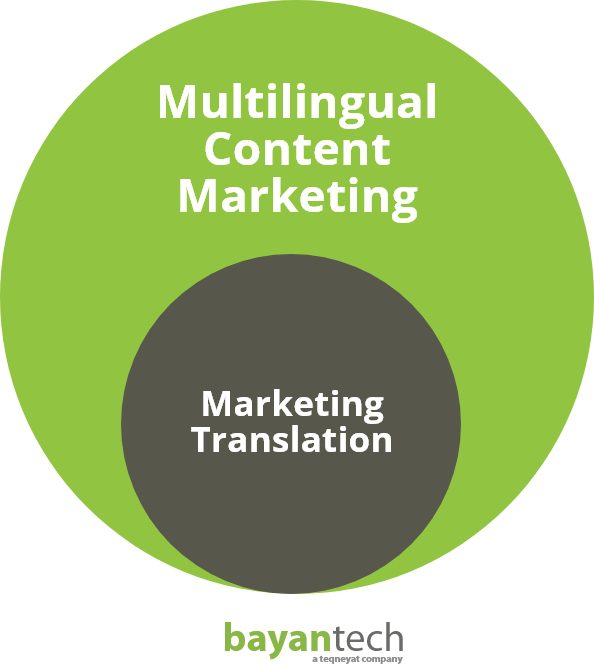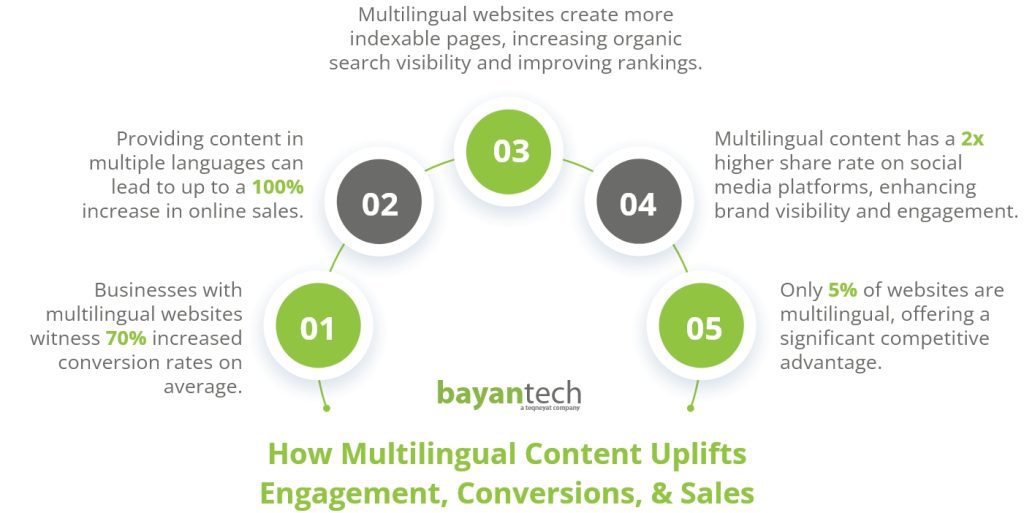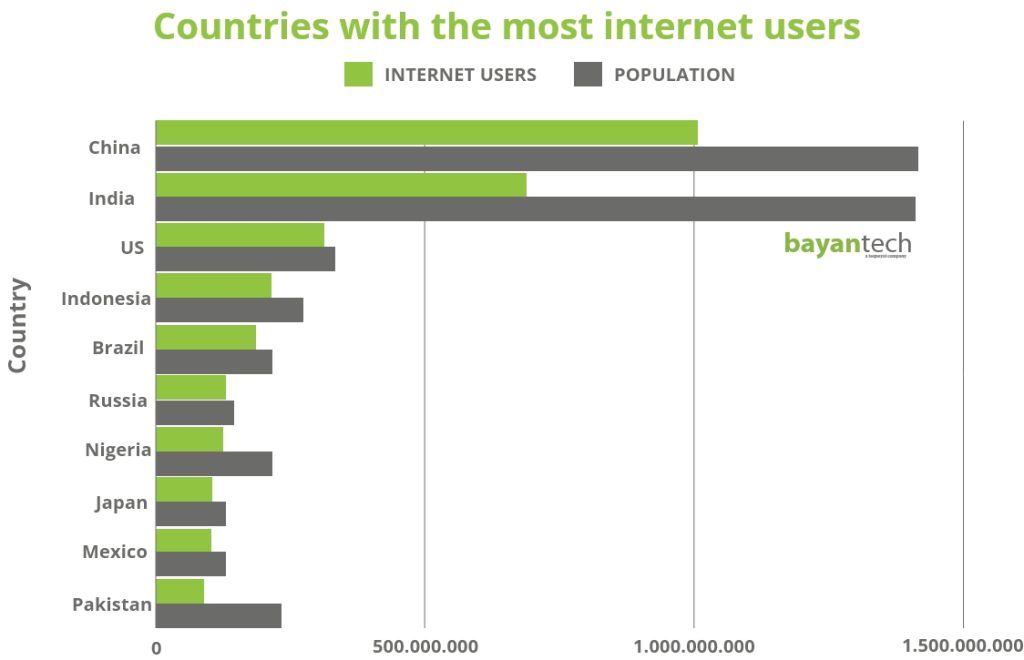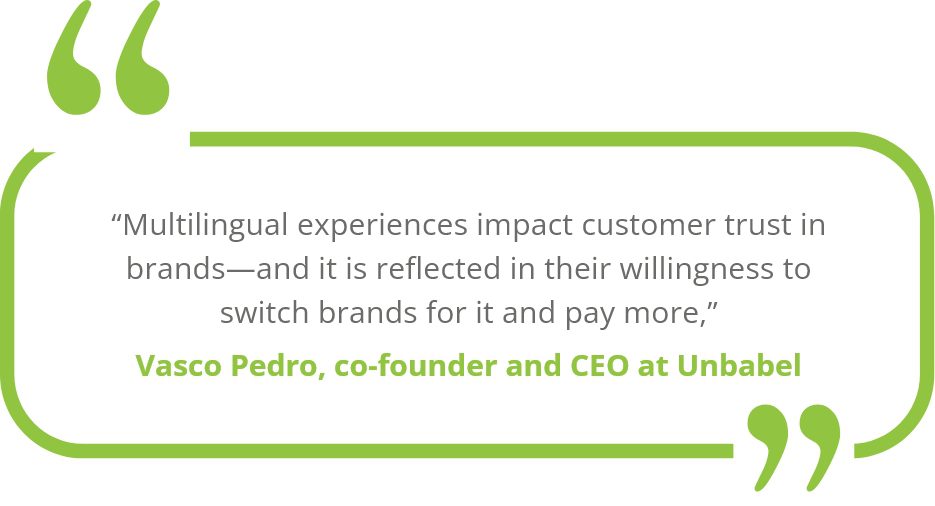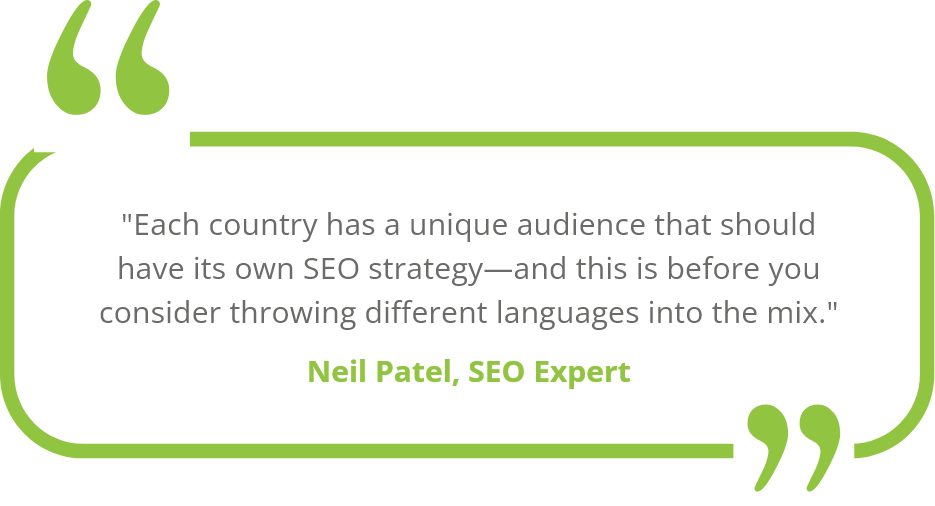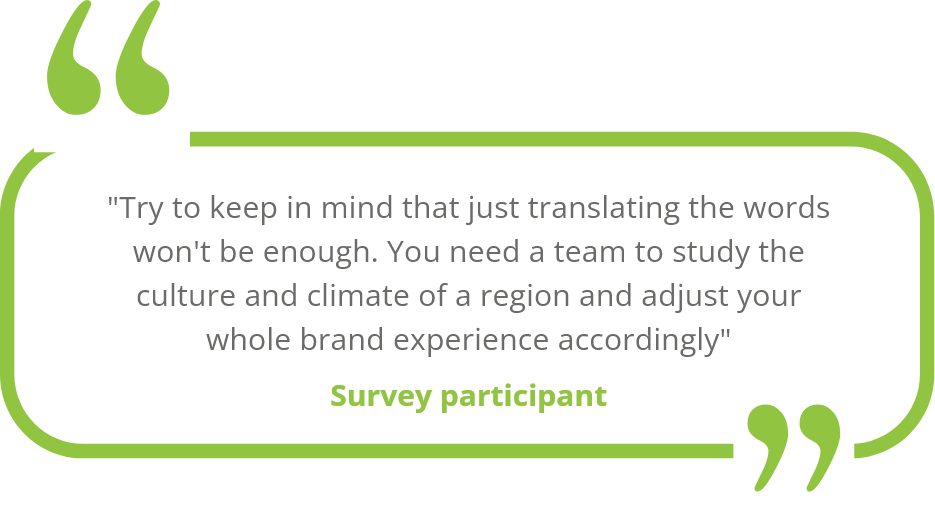Today, one piece of content can reach millions of users no matter where they are in the world. But this doesn’t magically happen — especially if your strategy doesn’t consider the rich diversity of populations across different regions and cultures.
When your content is not presented in the native language of your audience, your marketing efforts lose their effectiveness and fail to fulfill their intended purpose. Rather than engaging international users, foreign content risks excluding them.
If you really want to reach and resonate with global users and convert them into loyal customers, you need to include multilingual content marketing in your expansion plan, for it has the power to spark genuine connections that drive real business impact in every market you tap into.
But how do you optimize your content for maximum effectiveness in local markets?
This guide answers all your questions about multilingual content marketing, from how it adds value to your business to the best practices for ensuring its impact.
FAQ: What is Multilingual Content Marketing?
Multilingual content marketing is a tactic to create and distribute marketing content in multiple languages to target audiences in different regions. It involves tailoring all types of marketing materials from website content and blog posts to social media content and emails as well as the overall messaging of your marketing materials across different channels to resonate with your target audience.
Does it differ from marketing translation? The answer is a big YES.
Multilingual Content Marketing VS. Marketing Translation
Although marketing translation and multilingual content marketing both allow you to reach international audiences, they differ in their execution and effect.
Marketing translation primarily focuses on converting existing content into other languages to make it accessible globally. It involves extracting original messages and adapting them culturally for multilingual users.
On the other hand, multilingual content marketing takes a more customized approach by producing unique marketing content in each language tailored specifically to local markets. It demands more creativity to craft locale-specific content and campaigns with highly personalized messaging that deeply resonates with the locals.
But which route should you take when you’re looking to expand your digital reach?
While both tactics can aid the expansion of your online presence, multilingual content marketing may deliver stronger results for search engine ranking and connecting with the ideal local users. Crafting unique material attuned to local markets, allows your brand messaging to better satisfy audiences who are most likely searching for your content.
Let’s dig deeper into the key benefits of multilingual content marketing in the following points!
FAQ: Why Is Multilingual Content Important?
When done right, multilingual content marketing will make you stand out in a highly competitive marketplace and grow your market share. Here’s how:
1. Expanding Your Online Outreach
Many businesses assume that English is the most dominant language online and use it as their brand’s primary language thinking that global users can easily access their content.
But did you know native English speakers represent only about 5% of the global population?
As you can see below, the majority of internet users come from non-English speaking regions. So, it makes total sense that English websites only reach 25% of all internet users. What’s more, using a foreign language can also influence user engagement and decision-making. Research has found that:
- 65% of global consumers prefer content in their native language
- 73% want product reviews in their own language
- 76% choose products with information in their first language
- 33% don’t tolerate mixed languages on a website
Given the high standards of global users, multilingual content marketing enables you to overcome these barriers and enhances your brand visibility globally. By engaging with them in their native tongue, you bridge the physical and linguistic gap and connect with potential customers from across the globe.
2. Building a Strong Connection with Multilingual, Personalized Experiences
Whether your content’s goal is to educate or entertain, a strong emotional connection is what motivates users to keep coming back to your brand. However, if businesses rely on a one-size-fits-all strategy when catering to a wide spectrum of cultures, they will fail to forge this bond.
According to a survey of international consumers:
- 57% consider a brand biased when it does not offer end-to-end multilingual experiences.
- 64% would spend more with a brand that offers a customer experience in their language.
- 71% believe it’s important that brands promote their products/services in the customer’s language.
Furthermore, +60% of online shoppers said that brands that deliver impersonalized content would lose their customer’s loyalty. Global consumers have made it clear that they desire personalized experiences that speak to their interests and make them feel valued.
So, tailoring your content strategy for local markets significantly helps build lasting customer relationships. The reason is that it allows you to capture local sentiments and particular cultural nuances which fosters a genuine sense of inclusion crucial to build trust.
Moreover, multilingual content marketing demonstrates your willingness to serve those consumers in their own language. This shows your respect for their diversity and commitment to understanding them which positions you as a credible brand.
3. Boosting Brand Differentiation
Today, consumers are flooded with marketing messages and tons of ads on a daily basis. For this reason, generic content that lacks nuanced messaging falls short of intriguing online users and catching their attention.
When asked about the customer experience, international consumers said that less than 50% of brands offer multilingual experiences. If you manage to capitalize on this gap and fulfill the needs of those users, you gain a strong competitive edge in the market.
By using multilingual content, you’re able to customize your messaging to stand out from competitors who haven’t yet embraced personalized content strategies. This ensures that your brand remains at the forefront of local customers’ minds and positions you as a leader in the market.
4. Higher Conversion Rates
Multilingual content enhances key metrics by initially driving higher engagement rates. which leads to more search traffic and site visits. Ultimately, this results in a higher number of conversions and an increase in the volume of qualified leads.
Research shows that localization efforts, such as providing multilingual website content, can lead to a 47% increase in search traffic, 70% in website visits, and 20% higher conversion rates.
Let us explain how this works!
When you communicate with potential customers in their preferred language, you remove barriers that hinder their decision-making. This translates directly to higher conversion rates through more sales and sign-ups.
Additionally, people also respond more positively to brands that cater to them through relevant culturally informed content. Customized material like landing pages and email campaigns help encourage tangible interactions and conversions — increasing the potential for each engagement to result in valuable actions from customers.
5. Improving SEO Ranking and Visibility
Multilingual content marketing is an essential tool for better organic reach and higher rankings.
Typically, when local users search for a product or service, they do it in their own language. If your content isn’t accessible to these visitors, you miss out on a huge chunk of traffic. But this is not just about translation — there is also local search behavior and keyword performance.
Each market has its own search phrases and popular keywords that reflect how the locals naturally talk and search. With a tailored content marketing strategy, you can optimize your content individually for each target demographic.
This means employing strategic use of multilingual SEO keywords and creating resonant content that addresses local pain points and provides the users with answers to their search queries — improving, as a result, your site’s traffic.
Consequently, search engines will push your page to the top of domestic search results helping you reach more and more local visitors.
Did You Know that International SEO Is Integral to Your Multilingual Marketing Strategy?
ISEO is an impactful tactic that works hand in hand with your content marketing efforts to guarantee a higher global ranking. If you have no idea how this works or where to start, check our handy guide covering all the definitions, tools, and tricks you need to get started!
The 3 Pillars of Multilingual Content: How to Build an Effective Strategy
The are three approaches when it comes to creating multilingual content and each one serves a certain purpose. Choosing the appropriate strategy for each piece of content is crucial.
Here’s how you implement the right strategy and maximize effectiveness.
Direct Translation
The main goal of conventional translation is to accurately convey the meaning, tone, and intent of the source content. You should have existing original content that you want to convert into the target language. This straightforward approach suits low-impact content that doesn’t require much consideration for cultural contexts, such as:
- Product descriptions
- Instructional manuals
- FAQs and help articles
Localization and Adaptation
Localization dives deeper into the contextual elements and complex nuances that come with cross-cultural communication. This approach is about the careful adaptation of regional differences and variations. Localization requires linguistic and cultural fluency to perfectly capture local norms and avoid cultural insensitivity. It works best with:
- Blog posts and landing pages
- Graphics and imagery
- Updates and informative social media posts
- Email marketing campaigns and newsletters
- Video and audio content
Transcreation and Recreation
This is the main pillar of a successful multilingual content marketing plan. Transcreation gives creative freedom to authentically customize personalized content that just hits the mark. You can either use source text and tweak it creatively while preserving the core message or start creating content from scratch.
Often times your local copywriting team would have to produce 100% original content that relates to local events, holidays, and trends. This not only requires top-level language proficiency, but also a copywriting talent to craft emotionally resonant marketing messages.
Typically, you will need to transcreate:
- Geo-targeted landing pages
- Blog posts about local topics
- Interactive and engaging content
- Branded social media (trends, humor, etc)
- Local event activations
- Promotional campaigns
How Can You Measure the Effectiveness of Your Multilingual Content?
Multilingual content marketing is not a one-time thing — it’s an ongoing process of improvement. So, after you’ve fine-tuned your strategy to appeal to your diverse audiences, confirming that it’s yielding its true benefits and achieving your business goals is paramount.
In 3 simple steps, here’s how to examine the impact of your multilingual content and its role in attracting customers.
Track Key Metrics and Conversions
The first step is to track essential metrics like website traffic and conversion rates. You should be looking at:
- The volume and quality of visitors from various regions.
- The increase in traffic from your target regions.
- Bounce rates, time spent per session, and engagement metrics to understand whether the content truly resonates with target users.
- The percentage of visitors who take desired actions, such as making a purchase, submitting a contact form, or subscribing to a newsletter.
Analyze Social Media Engagement
You should track engagement levels on your social media page as well. Regularly monitoring likes, shares, comments, and click rates helps you assess the performance of different types of localized content. This is important for gaining a better understanding of what works well in the market and whether you need to refine your strategy.
Consider Customer Feedback
Collect feedback from your audience through feedback surveys, customer reviews, and comments. The feedback of end-users who perceive and interact with your content matters. By analyzing the customer sentiments, you better understand their satisfaction levels and identify areas of improvement.
Transform Your Online Presence with a Flawless Web Experience in 6 Steps!Discover the best practices for website localization to provide a seamless user experience. |
Maximize Your Digital Impact with bayantech Language Solutions
Thinking about upscaling your content marketing strategy and tapping into new regions? bayantech is a language service provider dedicated to guiding you along the way.
With nearly two decades of providing ISO-certified language solutions and marketing translation services, our language professionals are equipped to meet the highest quality standards.
With bayantech, you’re teaming up with a multidisciplinary team of native linguists, subject matter experts, copywriters, and localization specialists. Our services are available around the clock in +120 languages — tailored to our client’s needs.
Do you still feel lost and don’t know where to start? Let’s discuss your brand and see how we can help! Don’t hesitate to contact us.
Is your project material ready to go? Let our experts do their magic and request a FREE quote today.
8 Steps Every Medical Interpreter Takes
Looking for a medical interpreter? Discover the career path of medical interpreters and qualifications they need to acquire to take on interpreting jobs.


